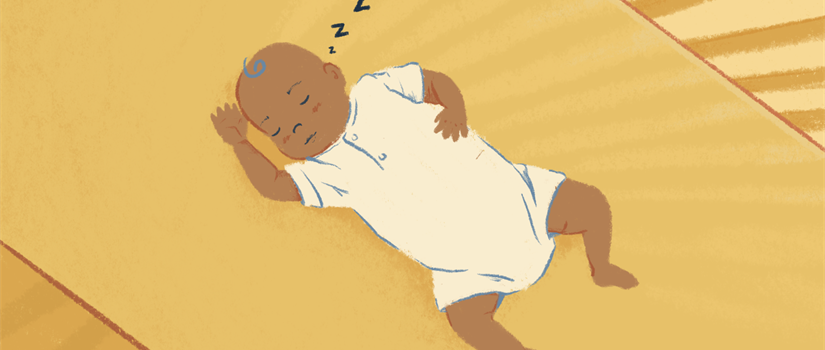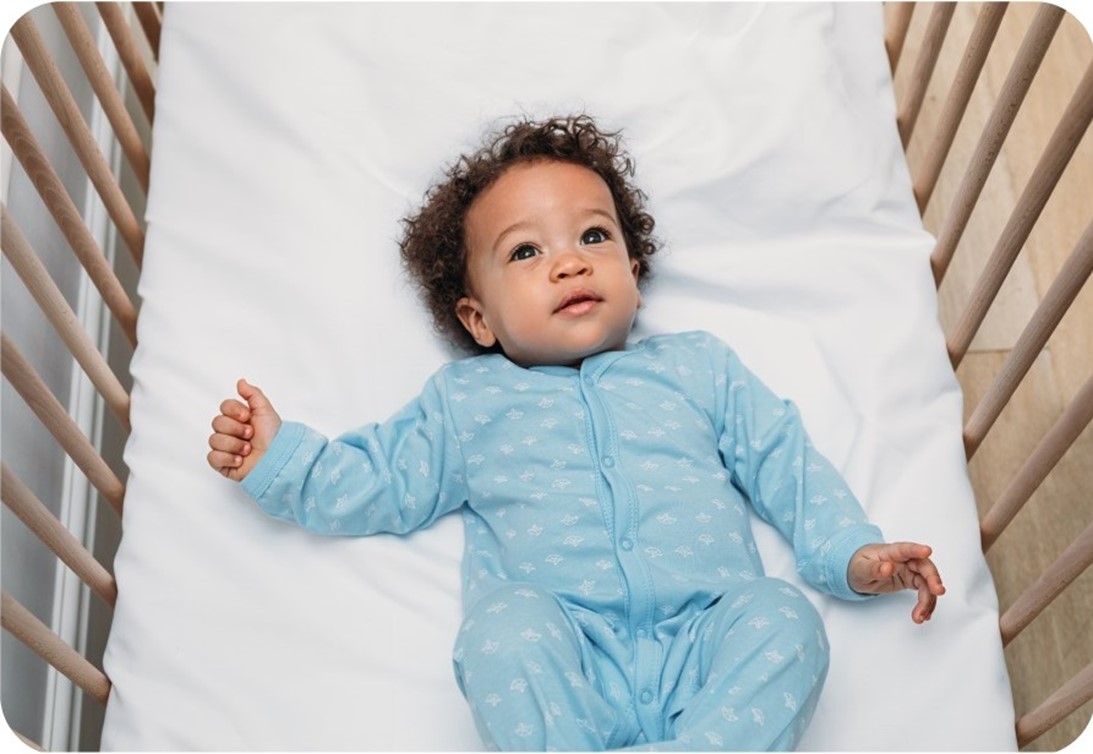Safe Sleep for Babies
en Español

Importance of Creating a Safe Sleep Area for Babies
Sleep-related deaths are one of the main causes of death for babies between one month and one year of age. In 2020, there were
192 Sudden and Unexpected Infant Deaths in California. These deaths
often occur during sleep or in the baby's sleep area .
Some examples of sleep-related deaths include:
- Baby getting trapped between two objects, such as a mattress and a pillow, and cannot breathe.
- Baby has something pressing on or wrapped around their neck, blocking their airway.
- Baby is sleeping in an adult bed with a parent or caregiver who accidentally rolls on top of them.
How to Create a Safe Sleep Area for Babies
The
safest place for your baby to sleep is on their
back,
alone, and in a
crib.
As a parent or caregiver, you can take steps to create a safe sleep area for your baby. When you create a safe area for your baby to sleep, you reduce the risk of sleep-related infant death.
4 Tips to Help Baby Sleep Safely
-
Always place baby
on their back for sleep, for naps, and at night.

-
Use a
flat, firm sleep surface, such as a mattress with a fitted sheet in a safety-approved crib, bassinet, or pack n' play.

-
Remove all toys, blankets, bumpers, and pillows from the crib.

-
Have a baby
share your room, not your bed.

Other tips for safe sleep:
- Keep your home and car smoke free.
- Avoid smoking, alcohol, marijuana, and drugs.
- Don't let your baby get overheated. Dress your baby in light and breathable clothing. You can check for signs of overheating such as sweating, a hot chest, or flushed skin.
- Don't use weighted blankets, weighted sleepers or swaddles, or other weighted objects on or near your baby.
- Breastfeed, if possible.
- Consider offering your baby a pacifier at nap time and bedtime.
- If you fall asleep while feeding your baby, transfer them to their crib or sleep area as soon as you wake up.
- If your baby falls asleep in a couch, armchair, car seat, stroller, swing or baby carrier, transfer them to their crib or safe sleep area as soon as you can.
Question and Answer
| What is the best way to reduce baby's risk of sleep related death? |
The best way to reduce baby's risk is to always place them on their back to sleep for all sleep times, on a firm, flat surface with no soft objects, toys, comforters, quilts, pillows, or blankets. |
| What are other sleep related deaths? |
Other sleep-related infant deaths are linked to how or where a baby sleeps or slept. They include:
- Suffocation: Something, such as a pillow or an adult's arm, covers baby's face and nose so they cannot breathe.
- Strangulation: Something presses on or wraps around baby's neck, blocking their airway.
- Entrapment or wedging: Baby gets trapped between two objects, such as a mattress and a wall and cannot breathe.
These deaths are different from
Sudden Infant Death Syndrome (SIDS) , but they are a type of
Sudden Unexpected Infant Death (SUID) . SIDS is the sudden death of a baby under one year of age where the cause of death is unknown, even after an investigation. SUID describes
all sudden unexpected infant deaths – including both those where a cause is eventually identified, and those without a known cause, such as SIDS.
|
| Is it safe to share a bed with my baby? |
No. Sharing an adult bed with baby increases the risk of SIDS, suffocation, and other sleep related infant deaths. It is recommended that you share your room, not your bed, with your baby for at least the first six months. Room sharing means baby has their own sleep area (crib, bassinet, or portable play yard) in your room, separate from your bed. |
Copy and paste the text to share on Facebook, Twitter or Instagram. To use corresponding graphics, click on photo to enlarge the image, then right click and “save as.” You will now be able to upload this higher resolution image to your social media site.
Pregnant? New parent? Are you searching for daycare or looking for someone to watch your baby?
Make sure there is a safe space for your baby under 1 year old to sleep.
Follow the ABCs of safe sleep:
-
Alone
- On their
back
- In a
crib, bassinet or pack n' play with no pillows, blankets or toys
Safe sleep saves lives.
Learn more by going to:
go.cdph.ca.gov/safesleep
#SafeSleepCA
If you have someone else watch your baby under 1 year old, ask them how they will create a safe space to sleep.
Follow the ABCs of safe sleep:
-
Alone
- On their
back
- In a
crib, bassinet or pack n' play with no pillows, blankets or toys
Safe sleep saves lives.
Learn more by going to:
go.cdph.ca.gov/safesleep
#SafeSleepCA
¿ Embarazada? ¿Padres primerizos? ¿Estás buscando guardería o alguien que cuide de tu bebé?
Asegúrate que tengan un espacio seguro para que duerma tu bebé menor de 1 año.
Sigue las indicaciones del “ABC” para que estén seguros a la hora de dormir.
-
Acostado solo
-
Boca arriba sobre la espalda
- En una
cuna, moisés, o cuna corral sin almohadas, mantas, o juguetes
Dormir de forma segura salva vidas.
Obtenga más información en:
go.cdph.ca.gov/safesleep
#DormirDeFormaSeguraCA
Si tienes a otra persona que cuida a tu bebé menor de 1 año, asegúrate de que siga los “ABCs” de dormir de forma segura.
-
Acostado solo
-
Boca arriba sobre la espalda
- En una
cuna, moisés, o cuna corral sin almohadas, mantas, o juguetes
Dormir de forma segura salva vidas.
Obtenga más información en:
go.cdph.ca.gov/safesleep
#DormirDeFormaSeguraCA
Resources